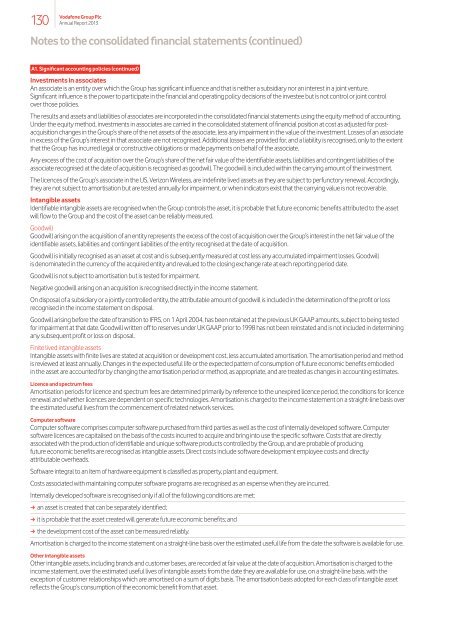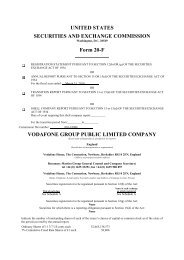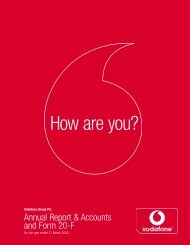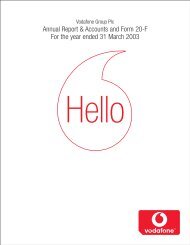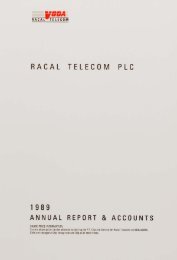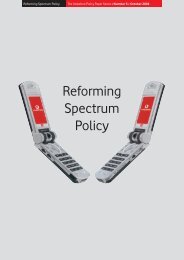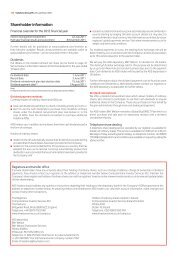The way ahead? - Vodafone
The way ahead? - Vodafone
The way ahead? - Vodafone
You also want an ePaper? Increase the reach of your titles
YUMPU automatically turns print PDFs into web optimized ePapers that Google loves.
130<br />
<strong>Vodafone</strong> Group Plc<br />
Annual Report 2013<br />
Notes to the consolidated financial statements (continued)<br />
A1. Significant accounting policies (continued)<br />
Investments in associates<br />
An associate is an entity over which the Group has significant influence and that is neither a subsidiary nor an interest in a joint venture.<br />
Significant influence is the power to participate in the financial and operating policy decisions of the investee but is not control or joint control<br />
over those policies.<br />
<strong>The</strong> results and assets and liabilities of associates are incorporated in the consolidated financial statements using the equity method of accounting.<br />
Under the equity method, investments in associates are carried in the consolidated statement of financial position at cost as adjusted for postacquisition<br />
changes in the Group’s share of the net assets of the associate, less any impairment in the value of the investment. Losses of an associate<br />
in excess of the Group’s interest in that associate are not recognised. Additional losses are provided for, and a liability is recognised, only to the extent<br />
that the Group has incurred legal or constructive obligations or made payments on behalf of the associate.<br />
Any excess of the cost of acquisition over the Group’s share of the net fair value of the identifiable assets, liabilities and contingent liabilities of the<br />
associate recognised at the date of acquisition is recognised as goodwill. <strong>The</strong> goodwill is included within the carrying amount of the investment.<br />
<strong>The</strong> licences of the Group’s associate in the US, Verizon Wireless, are indefinite lived assets as they are subject to perfunctory renewal. Accordingly,<br />
they are not subject to amortisation but are tested annually for impairment, or when indicators exist that the carrying value is not recoverable.<br />
Intangible assets<br />
Identifiable intangible assets are recognised when the Group controls the asset, it is probable that future economic benefits attributed to the asset<br />
will flow to the Group and the cost of the asset can be reliably measured.<br />
Goodwill<br />
Goodwill arising on the acquisition of an entity represents the excess of the cost of acquisition over the Group’s interest in the net fair value of the<br />
identifiable assets, liabilities and contingent liabilities of the entity recognised at the date of acquisition.<br />
Goodwill is initially recognised as an asset at cost and is subsequently measured at cost less any accumulated impairment losses. Goodwill<br />
is denominated in the currency of the acquired entity and revalued to the closing exchange rate at each reporting period date.<br />
Goodwill is not subject to amortisation but is tested for impairment.<br />
Negative goodwill arising on an acquisition is recognised directly in the income statement.<br />
On disposal of a subsidiary or a jointly controlled entity, the attributable amount of goodwill is included in the determination of the profit or loss<br />
recognised in the income statement on disposal.<br />
Goodwill arising before the date of transition to IFRS, on 1 April 2004, has been retained at the previous UK GAAP amounts, subject to being tested<br />
for impairment at that date. Goodwill written off to reserves under UK GAAP prior to 1998 has not been reinstated and is not included in determining<br />
any subsequent profit or loss on disposal.<br />
Finite lived intangible assets<br />
Intangible assets with finite lives are stated at acquisition or development cost, less accumulated amortisation. <strong>The</strong> amortisation period and method<br />
is reviewed at least annually. Changes in the expected useful life or the expected pattern of consumption of future economic benefits embodied<br />
in the asset are accounted for by changing the amortisation period or method, as appropriate, and are treated as changes in accounting estimates.<br />
Licence and spectrum fees<br />
Amortisation periods for licence and spectrum fees are determined primarily by reference to the unexpired licence period, the conditions for licence<br />
renewal and whether licences are dependent on specific technologies. Amortisation is charged to the income statement on a straight-line basis over<br />
the estimated useful lives from the commencement of related network services.<br />
Computer software<br />
Computer software comprises computer software purchased from third parties as well as the cost of internally developed software. Computer<br />
software licences are capitalised on the basis of the costs incurred to acquire and bring into use the specific software. Costs that are directly<br />
associated with the production of identifiable and unique software products controlled by the Group, and are probable of producing<br />
future economic benefits are recognised as intangible assets. Direct costs include software development employee costs and directly<br />
attributable overheads.<br />
Software integral to an item of hardware equipment is classified as property, plant and equipment.<br />
Costs associated with maintaining computer software programs are recognised as an expense when they are incurred.<br />
Internally developed software is recognised only if all of the following conditions are met:<br />
a an asset is created that can be separately identified;<br />
a it is probable that the asset created will generate future economic benefits; and<br />
a the development cost of the asset can be measured reliably.<br />
Amortisation is charged to the income statement on a straight-line basis over the estimated useful life from the date the software is available for use.<br />
Other intangible assets<br />
Other intangible assets, including brands and customer bases, are recorded at fair value at the date of acquisition. Amortisation is charged to the<br />
income statement, over the estimated useful lives of intangible assets from the date they are available for use, on a straight-line basis, with the<br />
exception of customer relationships which are amortised on a sum of digits basis. <strong>The</strong> amortisation basis adopted for each class of intangible asset<br />
reflects the Group’s consumption of the economic benefit from that asset.


